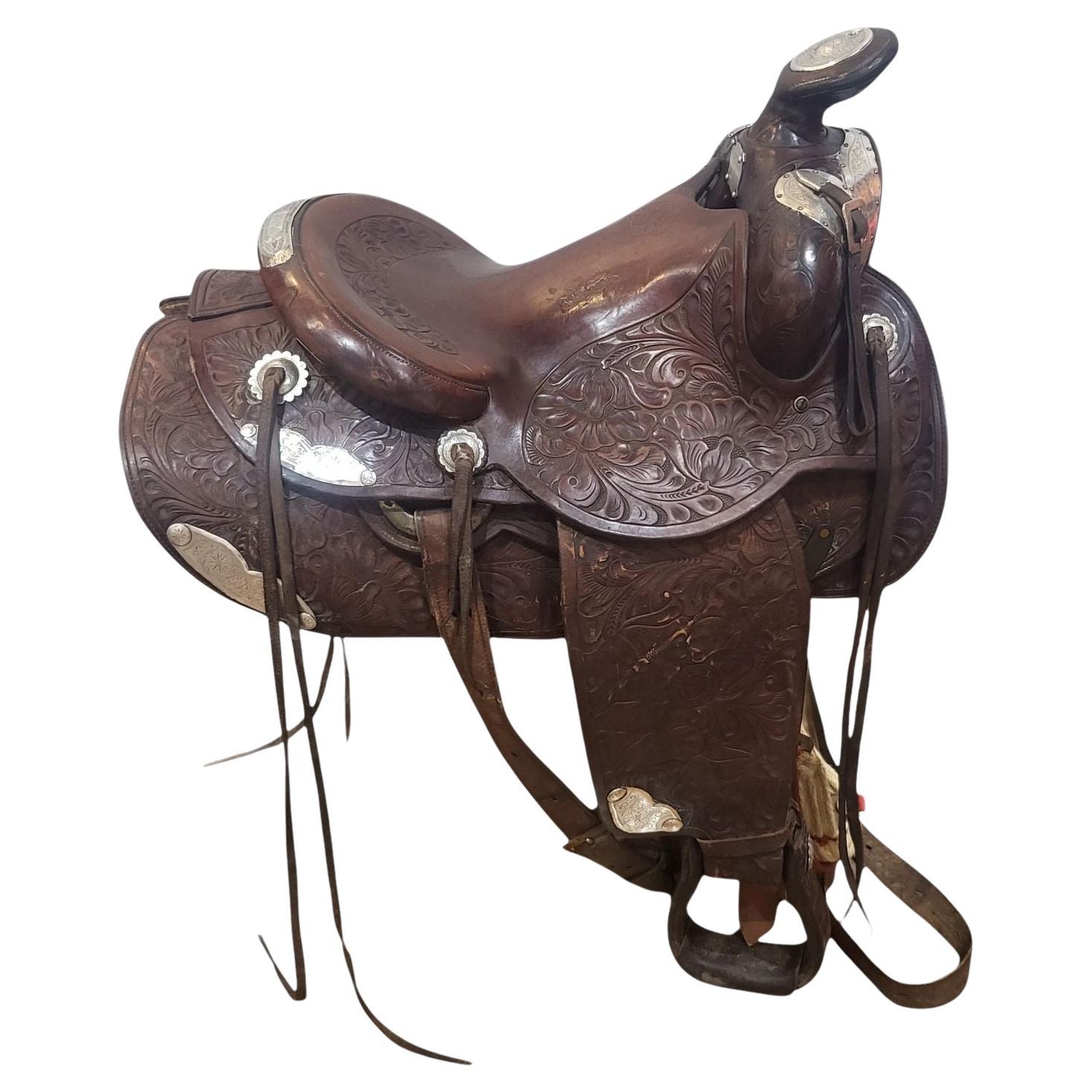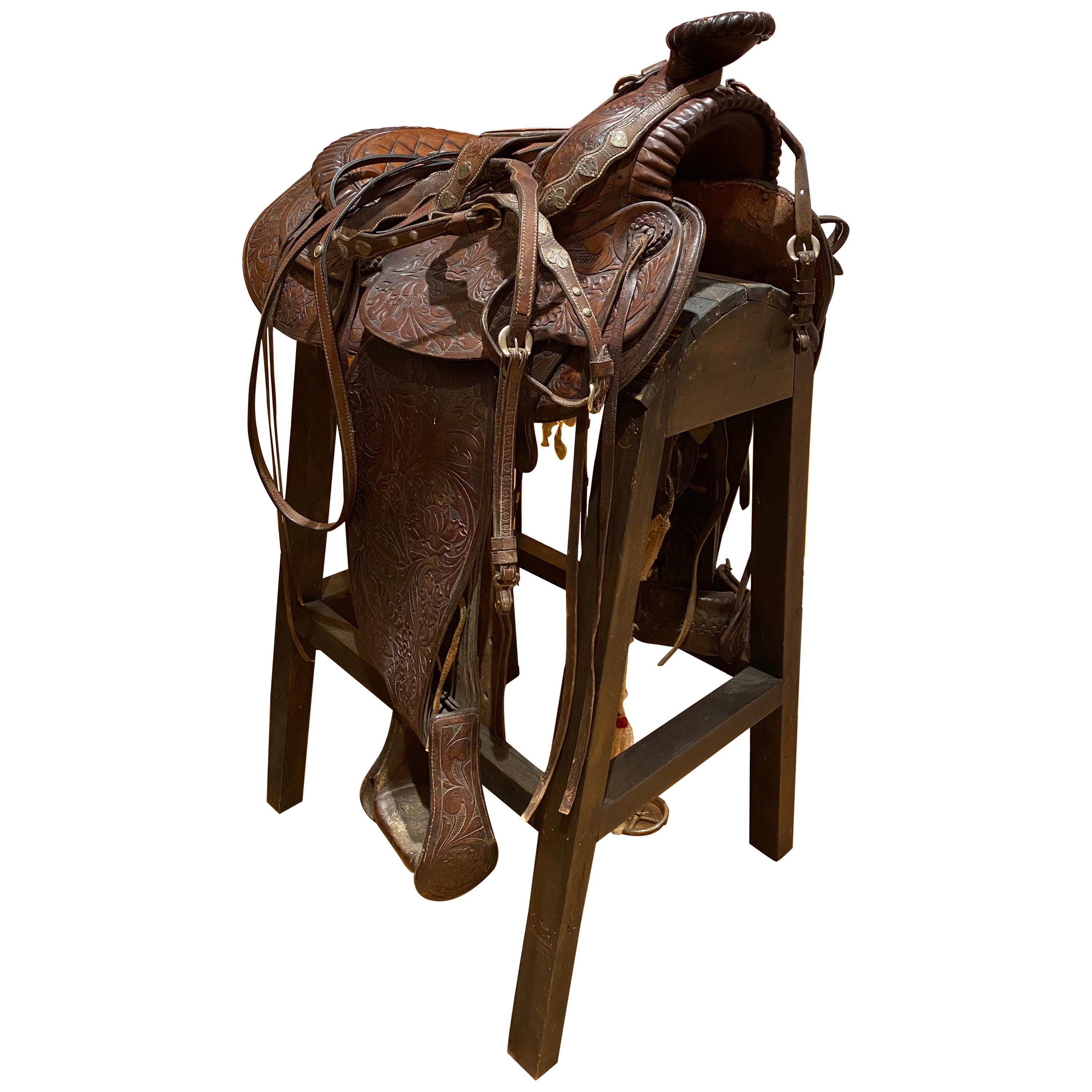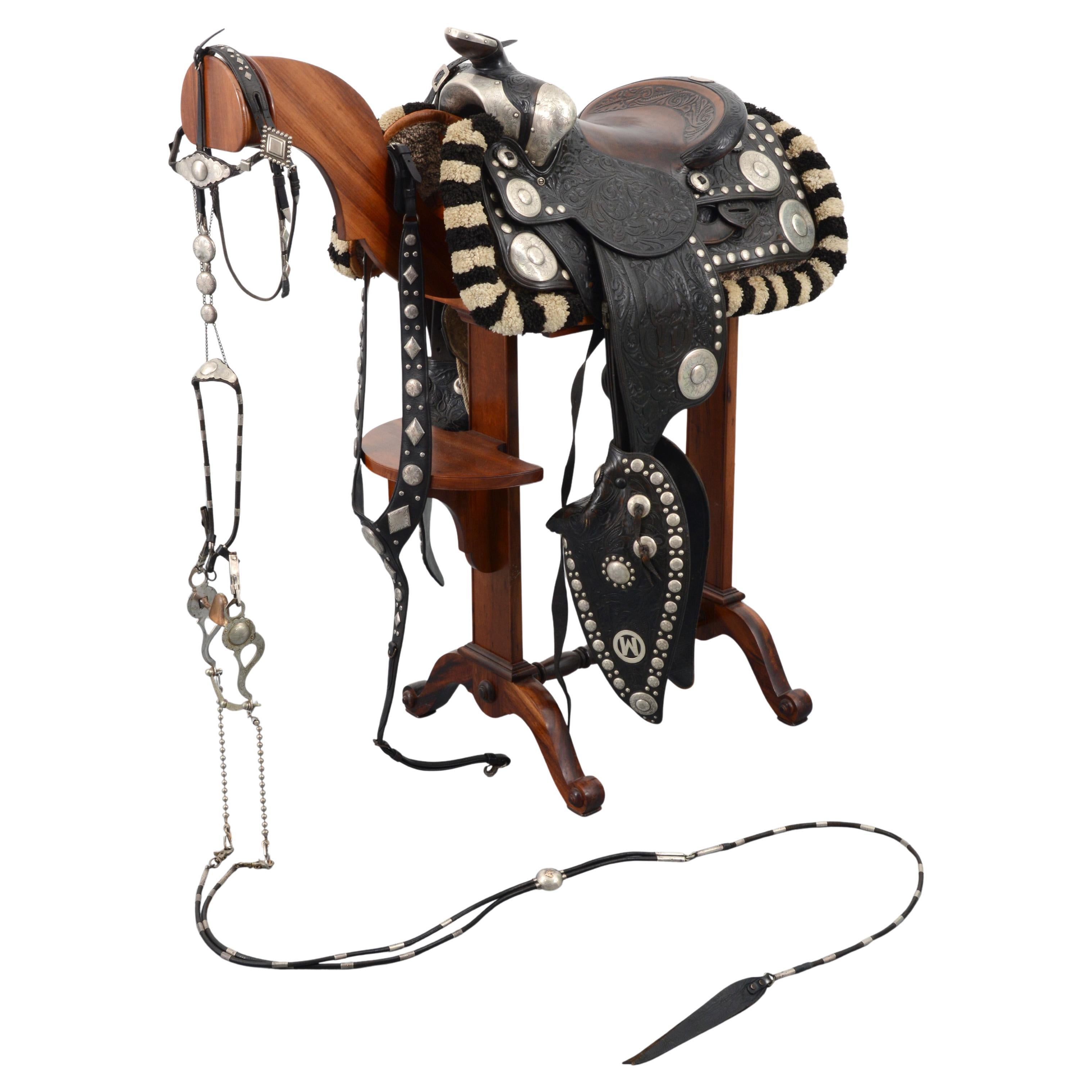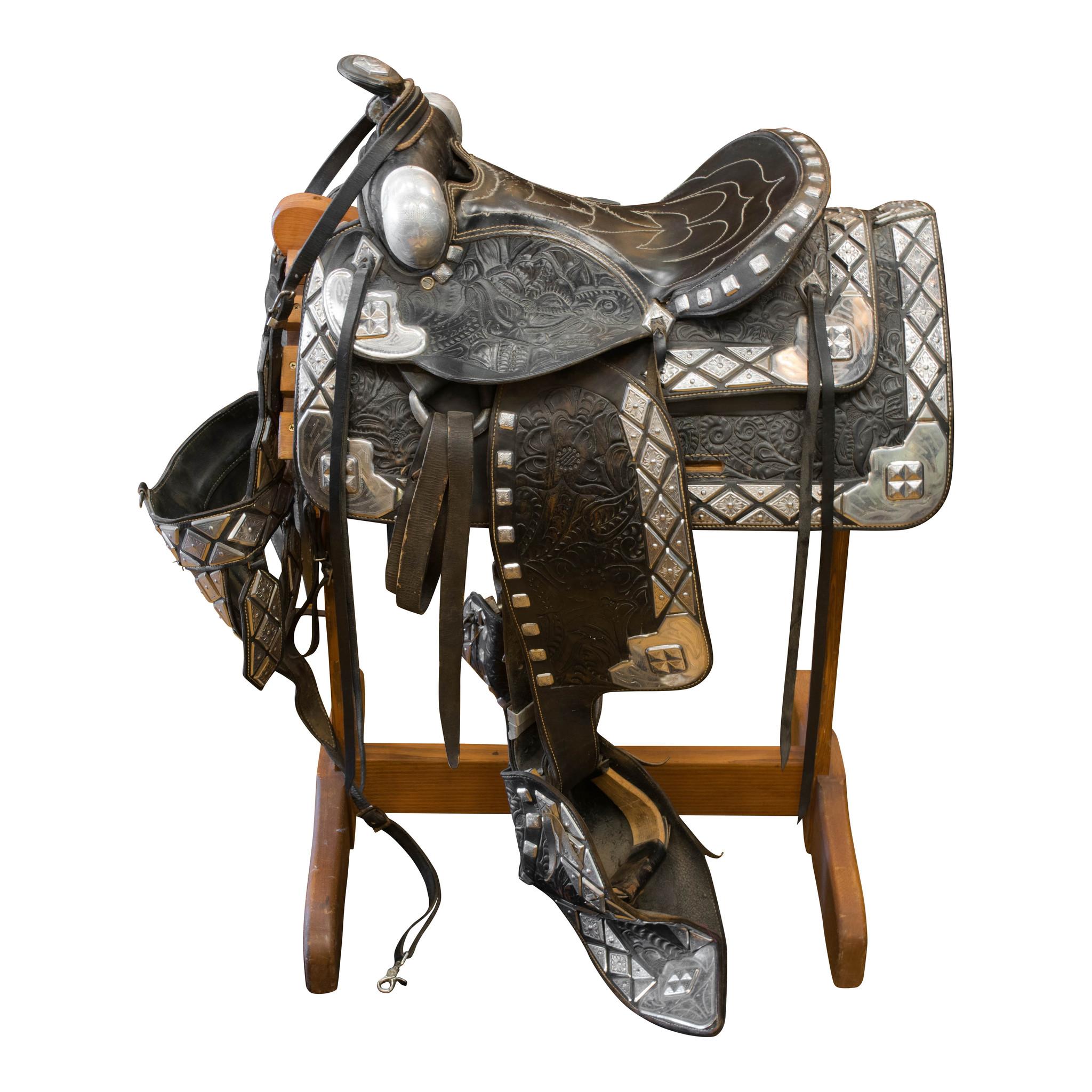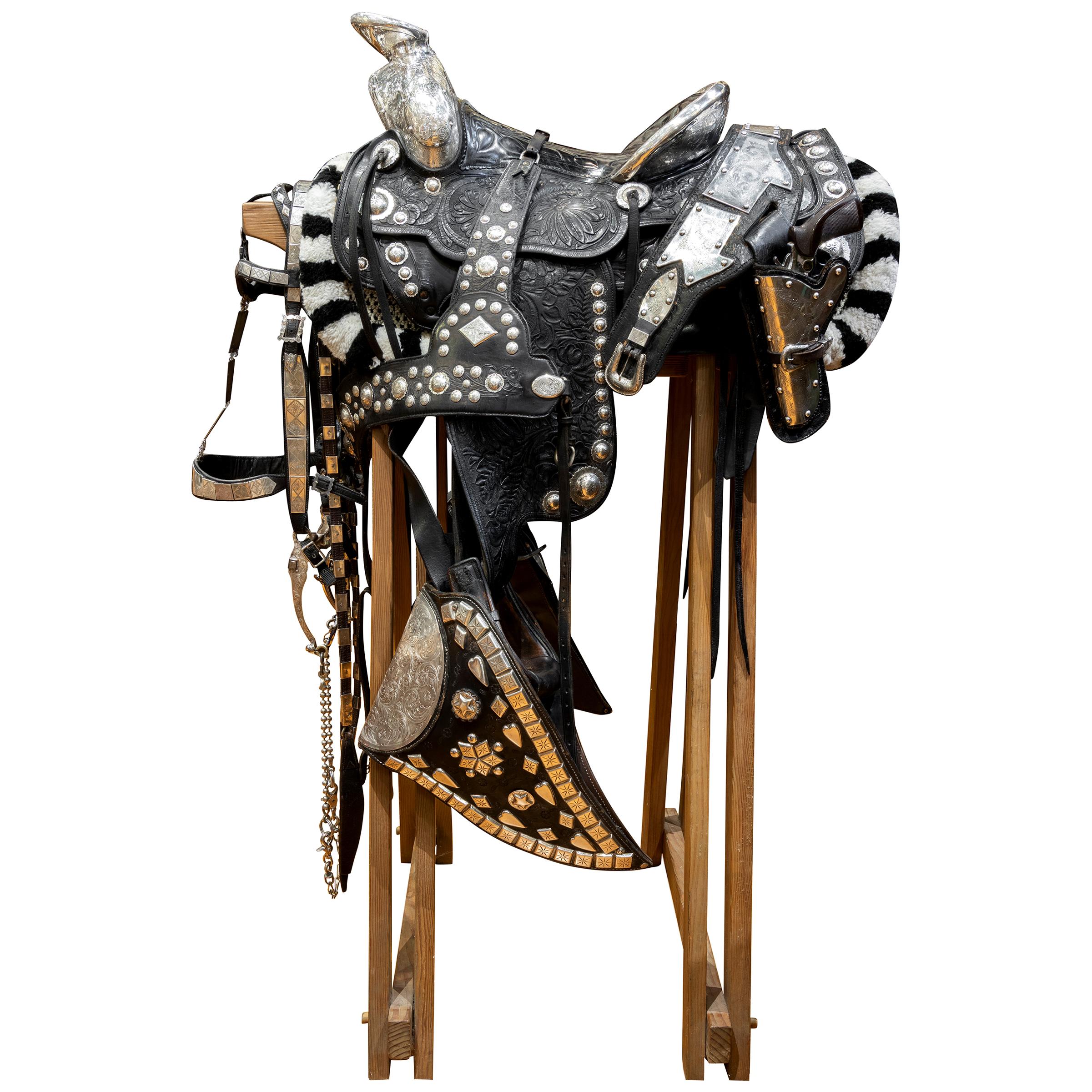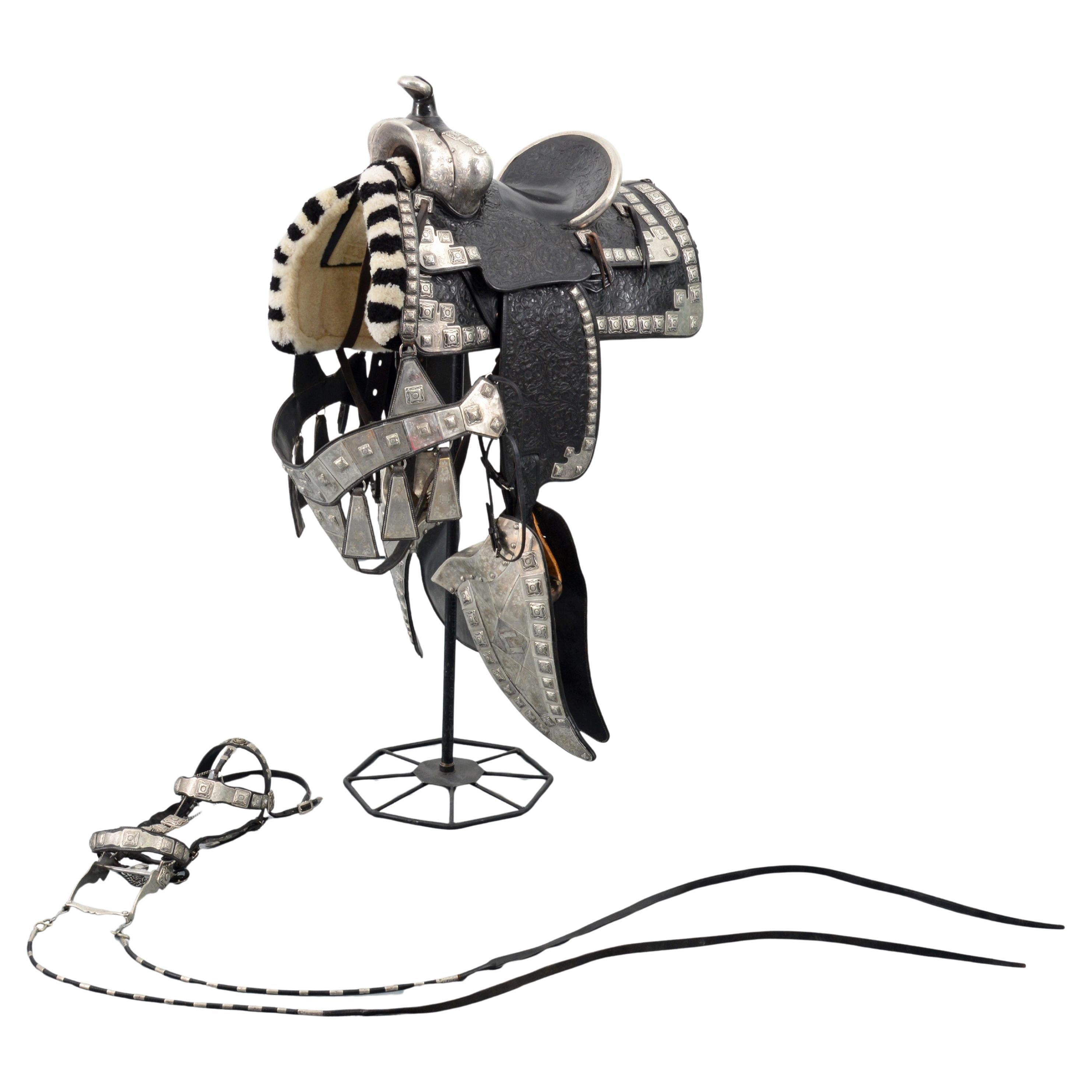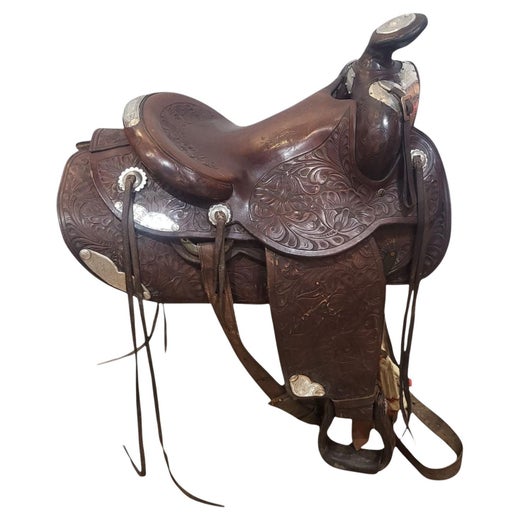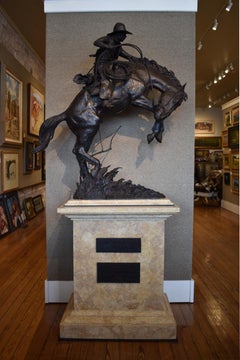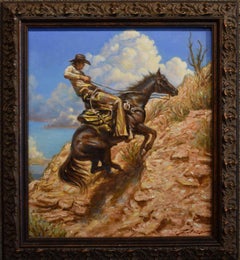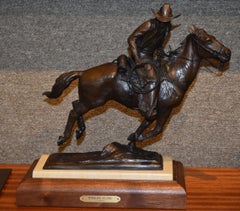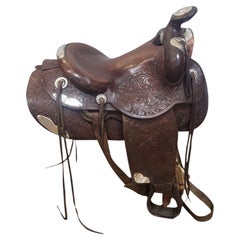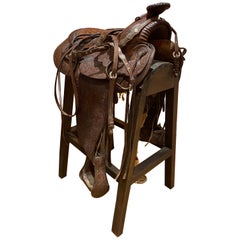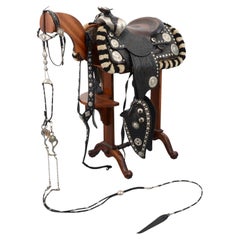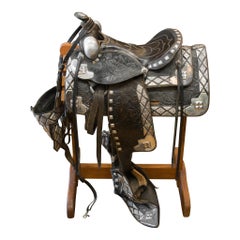Circa Late 1920s - Early 1930s. It is all Bohlin made and marked to include the saddle, the headstall and the breast collar. All made in Hollywood California. The only non-Bohlin item is the bit which appears to also be early California. There is some interesting provenance of the fine saddle. It was commissioned by Charles R. Bell, married to Margaret Vail Bell who was the daughter of Walter Vail. On the Bolin nameplate it has engraved, Vail Ranch as well as made for Charles Bell. Charles Bell Died in 1939.
The Vail Ranch has some great Western History which I will go into a little detail. You see, not only am I selling Saddles, but I’m also selling History.
If you want to skip the history lesson you can just scroll down past the following info to images of the saddle.
It’s no secret that ranching runs in the family blood. There is no greater example of that than California Rangeland Trust CEO Nita Vail. On April 14, 2018 Nita had the opportunity to witness her great-grandfather Walter L. Vail’s induction into the Hall of Great Westerners at the National Cowboy & Western Heritage Museum. This high honor is bestowed by the Museum to “exceptional individuals who have made an indelible impact upon the history of the great West.” A pivotal figure in early California and Arizona ranching, Walter Vail joins just over only 200 individuals who have been inducted into this esteemed hall.
The Vail legacy of advocacy and ranching lives on strongly through his descendants, including Nita.
All these years later, Nita carries the mantle of advocacy for ranchers in her own work at the California Rangeland Trust. Reflecting on her great-grandfather’s induction ceremony in Oklahoma, Nita says, “Witnessing my great-grandfather’s induction with family and friends was an incredible experience and a reminder of why I do what I do. Ranching plays an integral role in the culture, economy, and quality of life in California. Generations later, I get to honor Walter L. Vail’s legacy in my work with the California Rangeland Trust every day, preserving those open spaces for new generations and partnering with ranchers to continue to sustain life on the range in California.”
Walter Vail History
A native of Liverpool, Nova Scotia, Walter Vail purchased the 160-acre Empire Ranch southeast of Tucson, Arizona in 1876, along with an Englishman named Herbert Hislop. In 1882, the Empire Land & Cattle Company was formed with Walter L. Vail as principal shareholder. Over the years Vail, along with various partners, expanded the original land holdings to include over one million acres. The year after Walter purchased the Empire Ranch, the Southern Pacific Railroad built a railroad line, which was great news for the Vail family as it provided a means for them to ship their cattle.
Edward L. Vail, George Scholefield and Bird at the mouth of Rosemont Canyon ca. 1896-1898
Standing Up for Ranchers
In the fall of 1889, the Southern Pacific Railroad announced they would raise cattle freight rates by 25 percent. They ignored loud protests from ranchers who had already been hit hard by depressed cattle prices. In response, the Vails made a plan to drive the cattle overland themselves without the railroad. They knew that, if they were successful, they could break the railroad’s monopoly on the ranchers and force prices down.
Walter’s brother Edward Vail and foreman Tom Turner volunteered to drive the almost 1,000 steers on the 300-mile trip to the Warner Ranch in San Diego. The journey ahead would be grueling. Most of their trip was through desert with water sources 15 to 30 miles apart.
The ranchers would face a slew of obstacles—a stampede, a chaotic Colorado River crossing, an encounter with a group of horse thieves. In spite of all the dangers and challenges, they reached their destination. Just 71 days after leaving Arizona, the Empire cowboys arrived at the Warner Ranch. They had only lost 30 steers.
The historic Empire Ranch Trail Drive of 1890 inspired other Arizona ranchers to make similar drives as a stand against the railroad. That fall, a group of Arizona cattlemen met and agreed to fund improvements to establish a safe cattle trail from Tucson to California.
In response to the united stand of the ranchers, sparked by the Vails, the railroad finally agreed to restore the old freight rate—on the condition that the cattlemen would make no more cattle drives.
Walter Vail led by example, but he was also an active representative of ranching interests in the legislature. He served in the 10th Arizona Territorial Legislature in 1878 and in 1884 on the Pima County Board of Supervisors. He introduced two significant bills: One proposing the creation of Apache County in the northeastern corner or Arizona Territory, and the other calling for the repeal and replacement of a Pima County fencing ordinance. Elected to the Arizona Stock Growers Association in 1884, Walter L. Vail advocated for levying fines on outfits that brought diseased cattle into the Territory, proposed a system of recording brands and earmarks, and requested the establishment of the livestock sanitary commission to oversee quarantines on infectious diseases, and tighter trespass laws.
Moving to California
In the late 1880s when a long drought hit Arizona, the Vails began leasing California pastures and shipping increased numbers of their cattle there to fatten. This marked the beginning of Walter’s efforts to purchase land in Temecula Valley.
Vaqueros (Mexican cowboys) at the Empire Ranch in Arizona
In 1890, with growing corporate holdings in California, Walter Vail established his headquarters in downtown Los Angeles and moved his family there. By this time, he had pieced together four Mexican land grants—Pauba Rancho, Santa Rosa Rancho, Temecula Rancho and Little Temecula Rancho—to form the Pauba Ranch. Eventually, the Vails would own more than 87,500 acres surrounding the little town of Temecula. In 1892 they leased Catalina Island and in 1901-1902 in partnership with J. V. Vickers, they purchased most of the interests in Santa Rosa from the estate of A.P. More. In March of 1894, Vail and Gates joined Vickers in setting up a third cattle company, the Panhandle Pasture Company, with the hopes of expanding new markets in the east. The Panhandle Pasture Company bought seven thousand acres of grassland in Sherman County, Texas, and an equal amount across the line in Beaver County, Indian Territory (later Oklahoma).
Walter Vail was tragically killed in a Los Angeles streetcar accident in 1906. After his death, the Empire Land & Cattle Company (later renamed the Vail Company) assumed control of all his ranches and other real estate holdings. Walter had five sons and they would all have a hand in running the various ranches and the Vail Company as whole throughout their lives. The Empire Ranch in Arizona was sold in 1928. The Temecula area ranches continued to operate until it was sold in 1965. Santa Rosa Island, the last of Walter Vail’s holdings, was sold to the National Park Service in 1986, and ranching operations shut down there in 1998.
Walter Lennox Vail (May 13, 1852 - December 2, 1906) was an American businessman, cattle dealer, and politician. He is known for his Empire Land & Cattle Company (later the Vail Company), which spanned over one million acres throughout five states.[1] Vail has been called "a pivotal figure in early California and Arizona ranching."
Early life
Vail was born in Liverpool, Nova Scotia on May 13, 1852, to Mahlon Vail, Sr. and Eliza Vail.
Career
Empire Ranch
The headquarters of the Empire Ranch in the modern day
Vail left his family's Plainfield, New Jersey house in the middle of 1875 to pursue riches in the West. He worked for a few months in Virginia City, Nevada as a mine's timekeeper, but in November he wrote of his intention to get involved in Arizona's sheep business. He, along with an Englishman named Herbert R. Hislop, then purchased the Empire Ranch along with its 612 cattle on August 22, 1876. The purchase from Edward Nye Fish and Simon Silverberg cost $1,174 at the time and was only 0.25 square miles (0.65 km2). Vail had met Hislop for the first time in August of that year, at the Lick House in San Francisco. Vail also became the main shareholder of the Empire Land & Cattle Company, which was formed in 1882.
Politics
Vail additionally served in the House of Representatives on the 10th Arizona Territorial Legislature for two years, starting in 1879. He was one of five representatives from Pima County. There, he proposed the creation of Apache County in the northeast. In 1884, Vail was elected to the Arizona Stock Growers Association, where he introduced many laws relating to cattle farming.
California
Vail moved his main operations to California in the late 1880s due to a long drought in Arizona. He started leasing Californian land mainly in Temecula Valley, but established his headquarters in downtown Los Angeles. By this time, he had already bought four ranches: the northern half of Rancho Little Temecula, Rancho Pauba, Rancho Santa Rosa, and Rancho Temecula. Later, Vail would own over 135 square miles (350 km2) surrounding the city of Temecula. He also leased Santa Catalina Island and Purchased Santa Rosa Island in 1892 and 1901, respectively. Vail, along with Carroll W. Gates and J.V. Vickers, set up the Panhandle Pasture Company, which bought about 22 square miles (57 km2) in Sherman County, Texas and Beaver County, Oklahoma.
Personal life
Vail married Margaret "Maggie"[a] Newhall in 1881, with them having five children: Nathan Russel, Mahlon, Mary, Walter Lennox Jr., and William Banning (who used his middle name) together.
In 1890, a Gila monster bit Vail on his middle finger, and for years thereafter he experienced bleeding and swelling in his throat, which was thought to be caused by the venom from the bite.
Death
Vail died at 54 on December 2, 1906, due to complications from a tram (Trolley Car) accident in Los Angeles. He was cremated, then buried at the Hollywood Forever Cemetery on December 6.
Legacy
Vail's sons took over the company after his death, renaming it to the Vail Company. The Empire Ranch was sold in 1928, and the Temecula ranches were bought by a syndicate of companies, including Kaiser Aluminum, Kaiser Industries, and Macco Realties in 1965. Santa Rosa Island was acquired by the National Park Service in 1986, and ranching ceased in 1998.
Vail was inducted into the Hall of Great Westerners at the National Cowboy & Western Heritage Museum in 2018.[2] Various properties have been named after the Vail family including: Vail Headquarters, an outdoor shopping mall, Vail Lake, and Vail, Arizona.
In 1867, German immigrant, Louis Wolf, and his Chumash wife, Ramona, built a small adobe trading post next to Temecula Creek. Their Wolf Store helped launch the Temecula community, serving as a saloon, livery stable, legal services, hotel, general store, stagecoach stop, post office, school and employment agency. After Louis and Ramona’s deaths, their land and other Ranchos were purchased by Arizona cattle baron Walter Vail. By 1905, the 87,000-acre Vail Ranch became one of the largest cattle operations in California, stretching from Camp Pendleton to Vail Lake to Murrieta. It operated through the late 1970’s when it was sold to build Temecula’s housing. Some of the ranch’s oldest buildings survived in a cluster around the long-vacant Wolf Store. Together they would wait more than 40 years to be restored and once again become a center for community life in the Temecula Valley.
In 1905 after his death, Wolf’s Temecula was purchased by Arizona cattle baron Walter Vail, along with three other Ranchos totaling 87,500 acres. The sprawling Vail Ranch spread from South of Highway 79 to South of Clinton Keith Road, East to Vail Lake Resort and West to Camp Pendleton and continued operations through the late 1970’s when it was sold for housing subdivisions. The remaining buildings that comprised the Vail Ranch Headquarters, several having been demolished, have sat mostly vacant since then awaiting their restoration and re-use.
John N. Harvey, Edward L. Vail, Walter L. Vail, 1879
Ned Joins the Partnership - May 1879
In May of 1879 Walter’s older brother, Edward Lang Vail, known as Ned, joined the Empire Ranch partnership. He had no ranching experience but quickly learned. The Empire Ranch herds were finally sufficiently developed for sale, and the Empire Ranch found a ready market in the town of Tombstone and its nearby mines. Walter finally had sufficient funds to begin to pay off some of the loans from his Uncle Nathan and Aunt Anna.
North end of the original four rooms of the Empire Ranch House.
Empire Ranch Census Records - 1880
The 1880 U.S. Census documents that eight men were living full time at the Empire: the partners, Walter Vail, John Harvey and Ned Vail; John Randolph Vail, Uncle Nathan and Aunt Anna’s son; John Milton Requa, nephew of Isaac Requa who hired Walter in Virginia City; John Dillon, who was instrumental in locating the Total Wreck Mine; Tomás Lopez, a herder; and Mon Ta, the cook.
Section of Official Map of Pima County by Roskruge 1893.
The Southern Pacific Railroad Arrives in Pantano - April 1880
In 1880 the Southern Pacific Railroad finally reached Tucson and by April it was extended to Pantano, north of the Empire Ranch. The availability of rail transportation was a major boom to the Empire Ranch as it was now possible to sell cattle and beef to markets beyond Southern Arizona. The railroad also increased the availability of goods in Tucson and allowed for much quicker and safer transportation to California and the East.
Empire Ranch land acquisitions are highlighted in red. Courtesy of Dave Tuggle
Land Holdings Expand-1881-1882
Starting in 1881 the land holdings of the Empire Ranch expanded considerably. They acquired Charles and Agnes Paige’s Happy Valley Ranch near the Rincon Mountains in 1881. 1882 saw the addition of Don Alonzo Sanford’s Stock Valley Ranch totaling over twenty-eight square miles of grassland between the Whetstone and Empire Mountains.
Charles Bell Bohlin Saddle. All of the leather has been professionally cleaned and conditioned. All of the sterling has been professionally polished as are all of my saddles.
THE BOHLIN BRAND IS AS ICONIC AS THE FAMED WESTERN STARS that wore it. The late actor Richard Farnsworth sported a recognizable gold steer-head Bohlin buckle for decades, the engraving and edges worn smooth from years of daily wear, rodeo riding, and stunt work. When the Lone Ranger cried “Hi-yo, Silver!” as he rode to the rescue, both he and his white horse were equipped with Bohlin-made silver-mounted gear. Happily, The Bohlin Company that created these products in the 1940s continues today, maintaining original designs and traditions for fancy belt buckles and other jewelry in the mode of the company founder, all while innovating with new and exciting products to serve a contemporary audience.
Despite his cowboy credentials, when Ed Bohlin spoke there was an unmistakable residue of a Swedish accent that gave away his origins. He left the country of his birth when he was only 15 years old, arriving in New York in 1910 and immediately heading West, where by 1912 he was punching cattle in Montana. Four years later he was in Cody Wyoming, driving a stagecoach, working at area ranches, and learning to do leatherwork. He soon married and had a daughter, Lillian, but his wife tragically died in the influenza epidemic of 1918, leaving Bohlin alone to provide and care for his daughter.
After some crude attempts at fashioning silver and copper buckles, Bohlin opened his own leather shop in 1920. But after a second marriage failed, Bohlin – who had become proficient with twirling rope and shooting his Colt revolver – abandoned his business and joined a traveling Wild West show headed to the coast. It was just as well. His temper had gotten him in trouble with the law more than once, and it was time for him to move on.
Legend has it that during the show’s appearance at the Pantages Theatre in Los Angeles, Bohlin was approached by silent film Cowboy Tom Mix, who wanted to purchase his handcrafted calf-skin jacket. Others soon recognized the flare in Bohlin’s style, and he began to appear as an extra in cowboy movies and started making tooled leather gear for stars like Mix, William S. Hart, and others. In 1922 he opened the Hollywood Novelty Leather Shop and scratched out a living by making special pieces for film star Buck Jones and his wife Dell, who did stunt work. Major contracts to make leather outfits and harnesses for decidedly un-western films such as The Ten Commandments (1923) and Ben-Hur (1925) helped him keep solvent.
Bohlin’s firm was formally organized in Hollywood in 1926 as Edward H. Bohlin Inc. The shop moved many times over the next 19 years as the founder skillfully promoted his wares and developed some of the most enduring designs for Western-styled buckles, saddles, and accessories. He became a master of brand promotion, publishing lavish catalogs, turning his shop into a gathering place for real and imagined cowboys, and joining organizations like the exclusive men’s equestrian group, the Rancheros Vistadores, whose members then bought and displayed his products.
Bohlin’s ever expanding Hollywood associations included cowboy detective Charlie Siringo and artist Charlie Russell. He collaborated with Al Furstnow’s saddlery company, which was based in Montana but had set up a satellite shop in Hollywood, adding luxurious silver and gold embellishments to a saddle for Col. Tim McCoy, former Wyoming cowboy and first-rank cowboy movie star. Bohlin’s buckles, spurs, scarf slides, and jewelry could be spotted on Jackie Cooper, Clark Gable, John Wayne, Barbara Stanwyck, Clara Bow (the “It Girl” of the day), and scores more.
With the proliferation of low-budget western films, a new flock of performers took on the accessories of the Bohlin shop. Hopalong Cassidy (William Boyd), the Lone Ranger (Clayton Moore and John Hart), Roy Rogers, Ray “Crash” Corrigan, The Cisco Kid (Duncan Renaldo), Pancho (Leo Carrillo), Ken Maynard, and more adopted Bohlin gear for both performances and personal wear.
Even in the middle of the Great Depression, The Bohlin Company flourished, in large part thanks to the still-wealthy customers who rode in Pasadena’s Tournament of Roses Parade. Fancy silver-mounted horse gear had been used to show off finely bred horses and the gentry of California since the 1800s, and well-known Hispanic pioneer families such as the Sepulvedas and Yorbas continued to use Bohlin gear to display their prized equines well into the next century. Bohlin himself claimed to have ridden in every parade from 1922 until 1973.
Around the world, especially with the advent of television, the annual broadcast of the Rose Parade reinforced a clear image of elegant equestrian riders. The Los Angeles County Sheriff’s Silver Mounted Posse, the Long Beach Mounted Police, and many private horse groups predominantly used Bohlin gear. While the claim that The Bohlin Company made over 12,000 saddles cannot be reliably documented, the business flourished in the 1930’s and ‘40s.
A new Bohlin store opened on Highland Avenue in Hollywood in 1945; it was a one-stop shop with a full line of Western clothing, boots, gloves, hats, and anything else needed by a stylishly dressed rider or horse. Complete tack sets and riding outfits went to the Emperor of Japan, South American oil magnates, and European royalty. Bohlin-made prize buckles were awarded at rodeos on California, Colorado, and beyond, and riders from Kansas City horse shows to Indianapolis Shriner parades to Central Park riding clubs all sported Bohlin gear.
By the 1960s business began to decline, so Bohlin diversified once again, developing new products ranging from a peculiar iron camping stove to aluminum rifle cases. Inspired by his hero Charlie Russell, he turned his own hand toward bronze sculptures of Western wildlife. But the greatest creative endeavors of his waning years took him back to the beginning, designing some of the most elegant buckles and saddles in the Highland shop’s history for loyal customers, as well as for himself.
In 1996 the Autry Museum of Western Heritage staged a 5,000 square-foot exhibition of the most famous Bohlin gear and published this writer’s book Saddlemaker to the Stars: The Leather and Silver Art of Edward H. Bohlin. The Big Saddle bought and donated by Gene Autry himself was the star of the show.
A young Ed Bohlin
Edward H Bohlin Company
Saddlery-Saddle Maker
1895-1980
BP: Sweden
LKL: Hollywood, CA.
Born in Sweden in 1895, Edward Bohlin ran away from home at age 15, working his way to America on a huge four-mast schooner with dreams of Buffalo Bill Cody's Wild West in his head. Ed worked cattle drives around Montana before opening his first saddle shop in Cody, Wyoming where he did rope tricks in front of his shop to draw business. He met Tom Mix while performing at the Pantages Theatre in Hollywood and Mix convinced Ed to stay and produce silver and leather items in the Los Angeles area. From his humble beginnings to his fame in Hollywood for high-end pieces, Ed crafted more than 12,000 Bohlin saddles including many grand silver outfits of Tournament of Roses Parade fame. He also dressed many silver screen heroes and horses with his grand style of buckles, spurs and gun belts. His company was without equal among western style silversmiths building a reputation on flawless workmanship. The Edward H Bohlin company, which operated from the early 1920s through the 1980s (under Ed's watchful eye but continues to operate under other ownership), reached its apex in the 1930s when the Hollywood cowboys reigned supreme. Bohlin was a stickler for details and employed the finest silver and leather workers of his era to satisfy discriminating clients including Mae West, Hopalong Cassidy, Monte Hale, Lyndon Johnson and Ronald Reagan.
Bohlin Saddles
Ed Bohlin was known for his beautifully crafted parade saddles. A perfectionist, for good and bad, he never accepted anything less than the best craftsmanship. The leather on his saddles still squeak after 60 years. The silver requires only a cloth to clean because he used the highest grade of sterling. He and his artisans made many of the pieces by hand, especially the gold figures on his saddles. His carving was stunning and recognizable. Many of High Noon's customers remember going into Bohlin's shop as children while their fathers' purchased saddles, buckles, belts, bolos and money clips. Sometimes the kids got a special gift, too, from their dads. A few child's saddles (The Jackie Cooper model) were made to match their fathers for parades. The Tim McCoy model and others were made for the stars of the era. Fiesta was truly a work of art, both in the silver and the pictorial carving. The Murietta was one of his brilliant models, mounted with Indian and Tepee design with distant hills all done in three shades of gold. The Dicksons were used many times for riders who wanted to twinkle with silver in parades. Bohlin saddles have always been valued higher than any other maker and have kept their value throughout the years. Both riders and collectors of Western Americana still clamor for Bohlin, whether they plan to ride using them or only to display them proudly in their offices or living rooms as art.
It all started in the Wild West — Cody, Wyoming, to be exact. At the time, just a few years shy of the era known as the “Roaring ’20s,” Cody was a frontier town located on the fringes of Yellowstone National Park. The area’s wide-open ranges and rivers were teeming with wildlife, and Cody’s dusty streets were filled with cowboys, one of whom was named Edward H. Bohlin.
Bohlin followed the long-trodden path of a typical American dreamer by immigrating to the United States from Sweden at just 15 years old. He landed in New York City, but the call of the West quickly drew him out across the plains. It wasn’t long before he was a Western horse-riding, cattle-herding cowboy through and through. Bohlin opened a leather shop in Cody in 1920 that began the Bohlin Company.
Perhaps it’s fitting that a story about becoming a cowboy in the Wild West would also be a tale of making it big in Hollywood. That’s exactly what happened for Bohlin. Life’s twists and turns led Bohlin to take up a second career as a performer in a Wild West show headed to California. There he befriended movie cowboy Tom Mix. It was reportedly Mix who convinced Bohlin to try his hand at staying in Los Angeles, relocating his shop there to supply his work to the movie industry. In the decades that followed, Bohlin would become known for his beautifully intricate leather and silversmith work, designing buckles, saddles, gun holsters, and more for many of the brightest western stars of the silver screen as well as notable figures off-screen.
John Wayne and Rogers, all sported Bohlin designs in their time, but the legacy reached far beyond movie sets. Ed Bohlin rode in his first Tournament of Roses Parade in 1924, and by 1939, a majority of the parade’s equestrians outfitted their mounts in stunning tack built by Bohlin, which were seen by millions of TV viewers each year. Over the years, designs under the brand have become coveted, with many taking top dollar at auction. A Bohlin saddle from The Lone Ranger television show sold for more than $150,000 in 2018, and the Bohlin saddle for Rogers’ famous horse, Trigger, sold for more than double that amount. Some Bohlin Saddles sell in the $500,000 range.
Bohlin Through the Decades
1920: Edward H. Bohlin, a young Swedish immigrant turned cowboy, opens his first leather shop in the frontier town of Cody, Wyoming. By the mid-1920s, Bohlin has relocated his shop to Hollywood and his work is featured in adventure and western movies.
1930s: Early film stars and notable equestrians catch on to the Bohlin brand, helping to spur its popularity on- and off-screen.
1940s: Bohlin’s shop takes up residence at a prime new Hollywood location on Highland Avenue, where the company continues its track to great renown, making custom saddles and tack that are shipped worldwide. John Wayne rides in a Bohlin saddle during this time.
1950s: The Lone Ranger star Clayton Moore dons a masterpiece Bohlin gun belt befitting the famous cowboy character, but Bohlin buckles also infiltrate the horse show, parade, and professional rodeo scenes, becoming cherished pieces for everyday cowboys and cowgirls around the country.
1960s: Bohlin expands his silver and gold artistry into sculptures and more, but the focus on his high-quality saddles and belt buckles is not lost. Some of Bohlin’s most sought-after pieces are created during this time.
1970s: Business continues as usual for the Bohlin Company, but Ed himself, now reaching his 80s, slows down, eventually retiring from the company.
1980s: Edward H. Bohlin passes away in 1980, beginning a period of change for the company in which it has multiple owners. Yet the Bohlin brand maintains its high profile, even appearing in Larry Hagman’s wardrobe on the popular TV show Dallas.
1990s: The Autry Museum of the American West honors Edward H. Bohlin with an extensive exhibit and publishes the biographical book Saddlemaker to the Stars: The Leather and Silver Art of Edward H. Bohlin by James Nottage in 1996, amid uncertainty about the company’s future. Dave Marold, along with a group of investors, buys the Bohlin Company in 1999.
